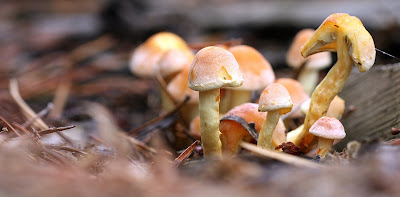Butterfly and dragonfly numbers have reduced significantly since I last found time to have a wander but there are still invertebrates to be found...
A shot that illustrates the autumnal feel nicely to begin with. This dock bug was the only one that I came across on this particular day. At this time of year they tend to congregate before hibernating and can be found in quite large numbers, usually on...you've guessed it-dock!
CLICK ANY PHOTO FOR A LARGER VIEW
 |
| A Hazel Leaf-roller Weevil (Apoderus coryli) |
Having said that, in mild winters, I have found them in November.
 |
| Carabid Beetle (Possibly Leistus) |
 |
| A Garden Tiger Moth Larva (Arctia caja) |
My next find was this caterpillar. I think this is the garden tiger moth larva. It was quite fast and I did wonder, as it was close to the ground if it was looking for somewhere to pupate.
I found a secluded spot where there was still some scabious in flower and as you'd expect, it was attracting a few insects...
I think this large hoverfly is probably Sericomyia silentis. It seems to be quite distinctive and although if the books are to be believed, this is around May-September, as we've already established, timings are all over the place this year again.
Both it's size and the habitat seem to fit as does the wing veneration from what I can make out.
Another hoverfly found on the same scabious plants was this Helophilus species one. Not exactly sure from this shot if it is H.pendulus or H.hybridus? Actually, scrap that! I think looking at the face, it may well be H.trivittatus? (Where's my pal Tim Ransom when I need him?)
There were also a good number of bees taking advantage of the late flowers too.
When I saw this couple of rhododendron hoppers in cop, pictured below, it crossed my mind that this behaviour is usually to be seen in spring-what then would be the purpose of mating this late in the year? Surely no young would result and so perhaps it was just for pleasure? I know...my brain works in very strange ways sometimes.
Of course the changing season has meant that we are now getting much damper conditions and that is just perfect for the fungi.....
When I saw this couple of rhododendron hoppers in cop, pictured below, it crossed my mind that this behaviour is usually to be seen in spring-what then would be the purpose of mating this late in the year? Surely no young would result and so perhaps it was just for pleasure? I know...my brain works in very strange ways sometimes.
 |
| Graphocephala fennahi |
I do spend a lot of time contemplating just how amazing and beautiful nature is, of course to portray it in such a one dimensional way is wrong on so many counts:nature is a tough environment where survival of the fittest still rules.
We all probably know that butterflies for instance are short lived, but it's still upsetting to see such a beautiful insect reduced to how I found the one in my next photograph...
This red admiral had lost most of its wings to what I guess must have been bird attacks. A very sad sight, especially bearing in mind that these are one of the species that can overwinter. It was amazingly still alive (just) at this point but there was nothing I could do to help, other than putting it out of its misery-and I couldn't bring myself to do that.
To complete this update I think I'll share a photo of another of nature's inventions that appear in all kinds of forms and manifestations at this time of year-these are the galls that are usually the work of tiny wasps and are to be found on all manner of trees and shrubs. This one I'm calling a marble gall. I have no idea if that is its correct title, it seems to fit though!
I suppose I should add that I found this one on oak. Now you're going to tell me it's actually called an 'oak gall' aren't you?
Until the next time then...
All photos taken using Canon 40d-Canon 100mm Macro and natural light, with the exception of the rhododendron hoppers where I added fill flash.
All photos taken using Canon 40d-Canon 100mm Macro and natural light, with the exception of the rhododendron hoppers where I added fill flash.













2 comments:
Hello again, your bottom gall looks a lot like Neuroterus anthracinus. Or something similar if not! Also your hairy wee caterpillar may be a Ruby Tiger?
Thanks for the gall i.d. I do struggle with these-the caterpillar, I went for garden tiger as I've photographed ruby tiger before and this one seemed very dark but you could well be right.
Post a Comment